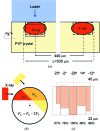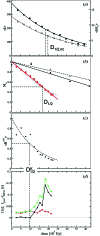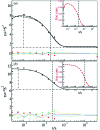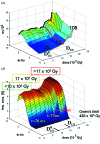The kinetic dose limit in room-temperature time-resolved macromolecular crystallography
- PMID: 22338689
- PMCID: PMC3284346
- DOI: 10.1107/S090904951105549X
The kinetic dose limit in room-temperature time-resolved macromolecular crystallography
Abstract
Protein X-ray structures are determined with ionizing radiation that damages the protein at high X-ray doses. As a result, diffraction patterns deteriorate with the increased absorbed dose. Several strategies such as sample freezing or scavenging of X-ray-generated free radicals are currently employed to minimize this damage. However, little is known about how the absorbed X-ray dose affects time-resolved Laue data collected at physiological temperatures where the protein is fully functional in the crystal, and how the kinetic analysis of such data depends on the absorbed dose. Here, direct evidence for the impact of radiation damage on the function of a protein is presented using time-resolved macromolecular crystallography. The effect of radiation damage on the kinetic analysis of time-resolved X-ray data is also explored.
Figures




 and the corresponding kinetic dose limit
and the corresponding kinetic dose limit  . (d) Red squares: relaxation times τRSV1 from the SVD analysis as a function of adjusted dose. The red dashed line is a guide to the eye. Green triangles: inverse of the rate coefficient (relaxation time τpost) obtained from posterior analysis. The green dashed line is a guide to the eye. Black spheres: difference between τpost and τRSV1. The dashed vertical line indicates the kinetic dose limit
. (d) Red squares: relaxation times τRSV1 from the SVD analysis as a function of adjusted dose. The red dashed line is a guide to the eye. Green triangles: inverse of the rate coefficient (relaxation time τpost) obtained from posterior analysis. The green dashed line is a guide to the eye. Black spheres: difference between τpost and τRSV1. The dashed vertical line indicates the kinetic dose limit  .
.

 is reached after 36 datasets or four short time-series. The offsets in the RVS are indicated by the dotted lines. Green dotted line: small offsets; orange dotted line: offset increases slightly; red dotted line: offset increases strongly. The orange regime ends after 72 datasets. The red line indicates that posterior analysis of the data beyond this dose will not be possible. D
1/2 is also indicated. (b) Three-dimensional plot of all fitted time courses from the posterior analysis as a function of dose. The green, orange and red regimes as well as the approximate relaxation times that can be expected in these regimes are marked.
is reached after 36 datasets or four short time-series. The offsets in the RVS are indicated by the dotted lines. Green dotted line: small offsets; orange dotted line: offset increases slightly; red dotted line: offset increases strongly. The orange regime ends after 72 datasets. The red line indicates that posterior analysis of the data beyond this dose will not be possible. D
1/2 is also indicated. (b) Three-dimensional plot of all fitted time courses from the posterior analysis as a function of dose. The green, orange and red regimes as well as the approximate relaxation times that can be expected in these regimes are marked.  , D
1/2 as well as Owen’s limit are also shown.
, D
1/2 as well as Owen’s limit are also shown.Similar articles
-
Protein energy landscapes determined by five-dimensional crystallography.Acta Crystallogr D Biol Crystallogr. 2013 Dec;69(Pt 12):2534-42. doi: 10.1107/S0907444913025997. Epub 2013 Nov 19. Acta Crystallogr D Biol Crystallogr. 2013. PMID: 24311594 Free PMC article.
-
The frontiers of time-resolved macromolecular crystallography: movies and chirped X-ray pulses.Faraday Discuss. 2003;122:65-77; discussion 79-88. doi: 10.1039/b201620f. Faraday Discuss. 2003. PMID: 12555850 Review.
-
Parameters affecting the X-ray dose absorbed by macromolecular crystals.J Synchrotron Radiat. 2005 May;12(Pt 3):268-75. doi: 10.1107/S0909049505003262. Epub 2005 Apr 14. J Synchrotron Radiat. 2005. PMID: 15840910
-
Towards time-resolved serial crystallography in a microfluidic device.Acta Crystallogr F Struct Biol Commun. 2015 Jul;71(Pt 7):823-30. doi: 10.1107/S2053230X15009061. Epub 2015 Jun 27. Acta Crystallogr F Struct Biol Commun. 2015. PMID: 26144226 Free PMC article.
-
'Cool' crystals: macromolecular cryocrystallography and radiation damage.Curr Opin Struct Biol. 2003 Oct;13(5):545-51. doi: 10.1016/j.sbi.2003.09.013. Curr Opin Struct Biol. 2003. PMID: 14568608 Review.
Cited by
-
Time-Resolved Macromolecular Crystallography at Pulsed X-ray Sources.Int J Mol Sci. 2019 Mar 20;20(6):1401. doi: 10.3390/ijms20061401. Int J Mol Sci. 2019. PMID: 30897736 Free PMC article. Review.
-
Protein energy landscapes determined by five-dimensional crystallography.Acta Crystallogr D Biol Crystallogr. 2013 Dec;69(Pt 12):2534-42. doi: 10.1107/S0907444913025997. Epub 2013 Nov 19. Acta Crystallogr D Biol Crystallogr. 2013. PMID: 24311594 Free PMC article.
-
Biological function investigated by time-resolved structure determination.Struct Dyn. 2023 Feb 21;10(1):010901. doi: 10.1063/4.0000177. eCollection 2023 Jan. Struct Dyn. 2023. PMID: 36846099 Free PMC article.
-
Kinetic modeling of the X-ray-induced damage to a metalloprotein.J Phys Chem B. 2013 Aug 8;117(31):9161-9. doi: 10.1021/jp403654n. Epub 2013 Jul 25. J Phys Chem B. 2013. PMID: 23815809 Free PMC article.
-
Room temperature structures beyond 1.5 Å by serial femtosecond crystallography.Struct Dyn. 2015 May 7;2(4):041708. doi: 10.1063/1.4919903. eCollection 2015 Jul. Struct Dyn. 2015. PMID: 26798807 Free PMC article.
References
-
- Adam, V., Royant, A., Nivière, V., Molina-Heredia, F. P. & Bourgeois, D. (2004). Structure, 12, 1729–1740. - PubMed
-
- Anderson, S., Srajer, V., Pahl, R., Rajagopal, S., Schotte, F., Anfinrud, P., Wulff, M. & Moffat, K. (2004). Structure, 12, 1039–1045. - PubMed
-
- Barker, A. I., Southworth-Davies, R. J., Paithankar, K. S., Carmichael, I. & Garman, E. F. (2009). J. Synchrotron Rad. 16, 205–216. - PubMed
-
- Berman, H. M., Battistuz, T., Bhat, T. N., Bluhm, W. F., Bourne, P. E., Burkhardt, K., Feng, Z., Gilliland, G. L., Iype, L., Jain, S., Fagan, P., Marvin, J., Padilla, D., Ravichandran, V., Schneider, B., Thanki, N., Weissig, H., Westbrook, J. D. & Zardecki, C. (2002). Acta Cryst. D58, 899–907. - PubMed
-
- Borgstahl, G. E., Williams, D. R. & Getzoff, E. D. (1995). Biochemistry, 34, 6278–6287. - PubMed
Publication types
MeSH terms
Substances
Grants and funding
LinkOut - more resources
Full Text Sources
Research Materials

